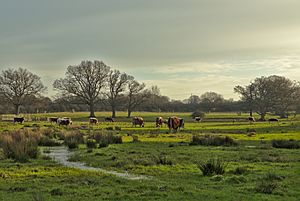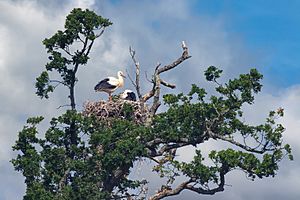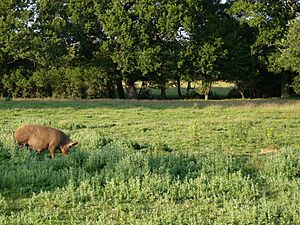Knepp Wildland facts for kids
Knepp Wildland is a special place in West Sussex, England, where nature is being allowed to take over. It's the first big "rewilding" project in lowland England. This means instead of farming, the land is being returned to a wilder state.
Knepp Wildland covers about 1,400 hectares (or 3,500 acres) of what used to be farmland. Since the year 2000, when they stopped intensive farming, this land has become home to many rare animals. You can find turtle doves, barbastelle bats, slow-worms, and grass snakes here. It's also a very important place for nightingales to nest and for purple emperor butterflies to breed. In 2020, White Stork chicks hatched here for the first time in England in 600 years! Plus, Beavers now live wild in Sussex at Knepp, which hasn't happened for 400 years.
History of Knepp Wildland
Sir Charles Burrell inherited the Knepp farm in 1983 when he was 21 years old. For 17 years, he tried to make the farm profitable, but it was very difficult. In 2000, he made a big decision: he sold his dairy cows and farm equipment. This helped him pay off debts instead of getting into more financial trouble by trying to farm even harder.
A turning point came in 2002. He received money from a program called Countryside Stewardship. This funding helped him restore 350 acres of parkland around the old castle. This area had been plowed for farming since World War II.
In 2001, the parkland around the castle was planted with grass and local wild meadow seeds. By the end of that year, all the internal fences in the park were removed. Deer from Petworth House were then brought in.
Sir Charles was inspired by a visit to a nature reserve in the Netherlands called Oostvaardersplassen in 2002. He also learned from a Dutch ecologist named Dr. Frans Vera. This led him to create a "hands-off" approach at Knepp. This means letting nature take its course, with some help from grazing animals. He brought in herds of old English longhorn cattle, Exmoor ponies, and Tamworth pigs. These animals act like the ancient aurochs, tarpan, and wild boar that once roamed Britain. Red and fallow deer were also added.
In 2003, the project got more funding to expand the park restoration to other parts of the estate. More English Longhorn Cattle and Exmoor ponies were added that year. In 2004, Tamworth sows (female pigs) and more Longhorn Cattle joined the project.
By 2006, a large part of the estate (about 1,100 acres) had been left completely wild for several years.
Amazing things started to happen. In 2009, Ravens nested at Knepp for the first time in hundreds of years. That summer, 13 out of 18 types of bats found in the UK were recorded. Many other important species, like insects, also returned. By March 2009, a long fence was built around a large section of the land. More Longhorn Cattle, Exmoor Ponies, Tamworth pigs, and Fallow deer were introduced there. Purple Emperor Butterflies were seen for the first time at Knepp that year. By 2015, Knepp had the largest breeding group of these butterflies in the country!
In 2010, the project received more funding. Just nine years into the project, Knepp was already home to about 1% of all nesting nightingales in the UK.
By 2011, there were many turtle doves singing at Knepp. In 2016, the first pair of breeding falcons appeared. Also in 2016, work was done on the River Adur that flows through Knepp. They removed artificial banks to let the river flood the surrounding meadows naturally. In 2012, the Environment Agency removed a large weir (a small dam) and disabled others. Within a year, Sea trout were seen migrating up the river.
In 2016, a Black Stork, which is very rare in Western Europe, was spotted. Experts also recorded 441 types of moths, and many species of bees and wasps, including some that are very important for conservation.
In 2020, White Stork chicks were successfully raised at Knepp. This was the first time in 600 years that this happened in the wild in the UK. Beavers were also introduced to Knepp in February 2020.
What Knepp Wildland is Like
At Knepp, they use herds of free-roaming animals to help create new habitats. These animals include Old English longhorn cattle, Exmoor ponies, Tamworth pigs, red deer, and fallow deer. Their grazing and natural behaviors help shape the land. This project has seen an amazing number of rare species return. These include turtle doves, barbastelle bats, slow-worms, and grass snakes. It's also a key breeding spot for purple emperor butterflies and nightingales.
A special program is underway to bring white storks back to England. Young storks are kept in a large pen until they are old enough to be released into the wild. Sussex was chosen because storks used to live there a long time ago. The goal is to have storks breeding in Britain again for the first time since 1416.
The Knepp Estate still produces some food. They raise about 75 tonnes of organic, pasture-fed meat each year from their free-roaming herds. This is done with very little impact on the environment. Wildlife tourism is another important way Knepp earns money.
Knepp offers camping, safaris, and holiday places to stay. There are 16 miles of public footpaths and 5 viewing platforms where you can watch the wildlife.
Knepp Wildland has an advisory board of over thirty ecologists. This group includes Dr. Frans Vera and Professor Sir John Lawton. They provide expert advice for the project.
The story of Knepp Wildland is told in a book called Wilding: The Return of Nature to a British Farm. It was written in 2018 by Isabella Tree. She lives at Knepp and is married to Charles Burrell. She helped create the Wildland project.
Awards and Recognition
- 2015: Won the People Environment Achievement (PEA) award for Nature.
- 2015: Received the Innovative & Novel Project award for their work on the River Adur restoration project.
- 2017: Awarded the Anders Wall Award for their special contribution to the rural environment in the European Union.
- 2017: Won Gold for Best Guided Tour of the Year at the Beautiful South Awards.
- Knepp Wildland is recognized as a Verified Conservation Area (VCA). It is also part of the Rewilding Europe Network.
- The UK Government's 25 Year Environment Plan highlights Knepp as an excellent example of large-scale nature restoration.
- It has received organic certification from the Soil Association.
- Sir Charles Burrell is involved in many conservation groups. He is the Chair of the Beaver Advisory Committee for England and Foundation Conservation Carpathia. He is also vice-chair for Rewilding Britain and serves on several other environmental boards.
Gallery













